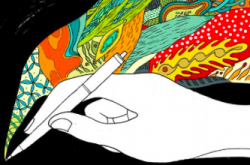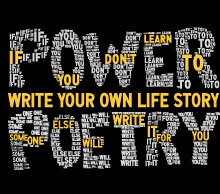
Power Poetry is the world's first and largest poetry community for teens — there are tens of thousands of poems in our community. We've decided to make a list of the top literary devices used in poems submitted by YOU!
In this guide we're going to break down some of the most useful (and used) poetic devices in literature and talk about why they work so well. These tools aren't just useful for writing poetry — they can be used to enhance your essays and prose as well. Keep reading to see if you use any of these techniques in your work (and if not, give 'em a go!).
- Metaphor (As seen in Unscrewing a Computer by linselyT): "I was a latent volcano with lust to erupt / only I didn't know it, the sides of my mouth / curling upwards in grotesque clown grins." Metaphors are arguably one of the most popular and recognizable poetic devices. A metaphor occurs when the writer says that one thing is something else. This is not to be confused with a simile, which compares one thing to another using the terms "like" or "as." Metaphors can use language to literally turn one object into another. The comparison is usually made between two unlike things in order to suggest a similarity between them. In the above quote the poet's mouth isn't like a sapphire of grapes, but rather their mouth is a bunch of red orbs. Metaphors are interesting because they make the reader lean into the poem by asking: "What does the poet mean by drawing this comparison?"
- Imagery (As seen in Lilac Petals by Ally Marie): "What makes a child innocent? / The seafoam blankets he brings to daycare every day." Forming a picture in a reader's mind is one of the most magical powers that writers possess. This creation of a mental picture is done through use of imagery. This technique works best if the language is forthcoming and vividly drawn. Think about sensory language that really helps the reader form a scene in their mind (i.e. the crunch of leaves on a forest floor, an autumn wind sweetened by pollen, a crystal blue sky yawning over the tree-tops). In the above poem, the author brings the blanket to the forefront of the reader's attention. Describing the child's blanket as "seafoam" invokes a smell, color, and texture. Here a single image manages to contextualize the blanket effectively. Being descriptive and detailed is another major key in making sure that the picture relayed is intentional and clear. Imagery should put the reader inside of the poem, giving them a more immersive reading experience.
- Line Breaks (As seen in The Ladder by liesl95): "Climb / down / toward / shame / thought / burning / why I bother trying?" Line breaks are a powerful and effective way to control both the pace and image of your poem. You can break your poem apart in order to give it space and allow the reader to view words individually or you can stack them atop each other. Writing in shorter lines allows you to control the reader's pace and can create an interesting visual experience. Intentionally breaking off lines gives you the power to redirect the reader's eye. If there is a word or sentence that you think is important, perhaps it should stand alone to give it greater impact. In this poem the writer uses line breaks to create the image of a ladder (this is also an example of concrete poetry). Similarly, an enjambment occurs when a sentence runs over into another line and occurs frequently in creative writing (the excerpt above is composed solely of enjambments). Line breaks can open up a world of creative opportunities regarding poetry.
- Repetition (As seen in Pretty Little Lady by Ink Blots): "Pretty Little Lady / with your roses and your scars / Pretty Little Lady / with your eyes as bright as stars / Pretty Little Lady / with your bruises and your laugh / Pretty Little Lady / with the life you can't get back" Repetition is another popular tool, easily recognizable to others because of its direct simplicity: it's just a matter of placing the same word or phrase multiple times throughout the poem. A form that relies heavily on repetition is the acrostic poem. Repetition goes hand in hand with rhythm as the reader's eye tends to gallop towards the next phrase. This technique also helps create a tempo for the reader to follow. In the above excerpy, the phrase "Pretty Little Lady is repeated throughout each stanza. This repetition helps the reader understand the consistency with which the narrator adores the woman being referred to, while also reaffirming who the writer is speaking to. It is in this way that repetition can be used symbolically, to prove a point.
- Alliteration (As seen in Barking Dogs from the Thunder by Kay Gould): "History's a cruel mystery / But how clever a pen / Cinema's sentiment's more cinnamon-sweet / We're amateur janitors just been sent in to sweep" Alliteration is another literary device that involves rhythm and sound. This device occurs when a writer uses the same sounds at the beginning of neighboring words. This is often a catchy way to create a rhythm or pattern in your poetry. In the quote above, the author uses the slippery sounds of the letters "S" and "C" to create a rhythm that leads into the second bar where the rest of the rhyme scheme takes place. Alliteration creates a smooth transition into the rhymes and seems to add an extra beat to each line. It can also create interesting cadences in your poetry and allow you to mix up your writing style.
Check out our Poetry Glossary for more poetry terms / literary devices.
